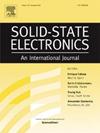Comparison of impact of channel length- and width-directional taper angle in nanosheet and forksheet FETs for 2 nm node and beyond
IF 1.4
4区 物理与天体物理
Q3 ENGINEERING, ELECTRICAL & ELECTRONIC
引用次数: 0
Abstract
Herein, an analysis of nanosheet field-effect transistors (NSFETs) and forksheet field-effect transistors (FSFETs) with 3 and 4 channel stacks is performed using fully calibrated technology computer-aided design (TCAD), to study the effect of the taper angle. Variations in the channel length- (ANS,L) and width-directional (ANS,W) angles, which inevitably occur during anisotropic etching, significantly affect both DC and AC performance. As ANS,L decreases, the longer channel decreases subthreshold swing (SS) and increases ballistic mobility, thereby improving the on-state current (Ion). However, at smaller ANS,L values, the source/drain (S/D) epitaxial volume decreases, reducing the stress on the channel and consequently decreasing Ion. Additionally, the on-state gate capacitance (Cgg_on) increases as ANS,L decreases. In contrast, a smaller ANS,W increases Ion due to the increased effective channel width (Weff). Notably, the 4-stack configuration shows a larger Ion than the 3-stack as ANS,W decreases, attributed to the additional Weff in the bottom channel of the 4-stack. Similar to ANS,L, Cgg_on increases as ANS,W decreases. As all-directional taper angle (ANS,B) decreases, both Ion and Cgg_on increase because ANS,L and ANS,W simultaneously influence these parameters. Although this effect increases the RC delay in both NSFETs and FSFETs as ANS,B decreases, FSFETs are more sensitive to RC delay than NSFETs. Furthermore, 4-stack FSFETs exhibit significant degradation in RC delay compared to NSFETs, owing to their high RC delay sensitivity in high-stack configurations. Despite the advantages of FSFETs over NSFETs in terms of RC delay and area reduction, these results indicate that FSFETs are highly sensitive to taper angle variations, particularly in high-stack configurations, potentially negating their RC delay benefits.
纳米片和叉片fet通道长度和宽度方向锥度角对2nm及以上节点影响的比较
本文采用计算机辅助设计(TCAD)技术对具有3沟道和4沟道堆叠的纳米片场效应晶体管(nsfet)和叉片场效应晶体管(fsfet)进行了分析,研究了锥度角的影响。在各向异性蚀刻过程中,不可避免地会发生通道长度角(ANS,L)和宽度方向角(ANS,W)的变化,这会显著影响直流和交流性能。随着ANS、L的减小,较长的通道降低了亚阈值摆幅(SS),增加了弹道迁移率,从而提高了导通电流(Ion)。然而,在较小的ANS,L值下,源/漏极(S/D)外延体积减小,减小了通道上的应力,从而减少了离子。此外,导通状态栅电容(Cgg_on)随ANS、L的减小而增大。相比之下,较小的ANS,W增加离子由于增加的有效通道宽度(Weff)。值得注意的是,当ANS和W减小时,4堆栈的配置显示出比3堆栈更大的离子,这归因于4堆栈底部通道中额外的Weff。与ANS相似,L、Cgg_on随ANS、W的减小而增大。随着全向锥角(ANS,B)的减小,离子和Cgg_on均增加,因为ANS、L和ANS,W同时影响这些参数。虽然这种效应增加了nsfet和fsfet的RC延迟,但随着ANS,B的减小,fsfet比nsfet对RC延迟更敏感。此外,与nsfet相比,4层fsfet在RC延迟方面表现出显著的退化,这是因为它们在高堆栈配置下具有较高的RC延迟灵敏度。尽管fsfet在RC延迟和面积减小方面优于nsfet,但这些结果表明fsfet对锥度角变化非常敏感,特别是在高堆叠配置下,这可能会抵消其RC延迟优势。
本文章由计算机程序翻译,如有差异,请以英文原文为准。
求助全文
约1分钟内获得全文
求助全文
来源期刊

Solid-state Electronics
物理-工程:电子与电气
CiteScore
3.00
自引率
5.90%
发文量
212
审稿时长
3 months
期刊介绍:
It is the aim of this journal to bring together in one publication outstanding papers reporting new and original work in the following areas: (1) applications of solid-state physics and technology to electronics and optoelectronics, including theory and device design; (2) optical, electrical, morphological characterization techniques and parameter extraction of devices; (3) fabrication of semiconductor devices, and also device-related materials growth, measurement and evaluation; (4) the physics and modeling of submicron and nanoscale microelectronic and optoelectronic devices, including processing, measurement, and performance evaluation; (5) applications of numerical methods to the modeling and simulation of solid-state devices and processes; and (6) nanoscale electronic and optoelectronic devices, photovoltaics, sensors, and MEMS based on semiconductor and alternative electronic materials; (7) synthesis and electrooptical properties of materials for novel devices.
 求助内容:
求助内容: 应助结果提醒方式:
应助结果提醒方式:


